Arts and Culture
BeautyTech, BabyTech, Join FitTech, HealthTech at CES 2017 Las Vegas

CES 2017 Las Vegas is the continuation of the expansion of the word “tech”. First, it was HeathTech, or tech devices for healthcare. Then there was “FitTech” which refers to tech gadgets for working out and fitness. Now, we have, and for the second year at CES, BeautyTech and Baby Tech. (Zennie62 , Zennie Abraham coverage of CES 2017 is sponsored by The Oakland Post and Sigma Technologies Global. Be sure to subscribe to Zennie62 on YouTube.)
Overall, the establishment of these subsections of “tech” reflect the growing number of startups and gadgets that apply modern micro-computer electronics and programming to help solve problems we face in our everyday lives (like when to take a medication or measuring blood pressure reliably when a doctor is not available) or make some aspect of our daily practices easier to do.
I vividly recall standing at the steps in the Las Vegas Convention Center South Hall two years ago, and marveling at how one section in front of me had grown between that year, 2013, and the previous CES 2012: The HealthTech Area, or technical gadgets with a healthcare focus. Then, in 2014, that area was changed and added fit models riding stationary bikes, and running, and wearing not much at all, and to the objective of getting you to check out the newest in something called FitTech, which others call Wearable Tech. The ruler of the roost was a then seven-year-old company called FitBit.
Now, FitBit is a public company worth $4 billion, and worried about the large and growing number of startups aiming to under-cut its dominance with devices like Skulpt Chisel, which I vlogged about at CES 2016. Much fun was had with the amazing Laura Myren, who explains that it measures body fat and muscle quality. Just the thing for after-gym evaluation of your workout.

Ok, so what’s BeautyTech and BabyTech all about?
Well, while all that’s happening, other entrepreneurs are pivoting toward two related and even more concentrated areas of Wearable Tech: BeautyTech and BabyTech.
As CES itself explains in introducing the Baby Tech Summit, the term focuses on devices “From smart car seats and breast pumps to at-home medical diagnostics tools and cutting-edge cognitive learning wearables.” BabyTech is so new as a niche that a search reveals as the top-most Google result, the blog for the 2016 CES BabyTech Summit. There’s no dominant player in this area – yet.
The same can be said for BeautyTech, which one observer, Arabelle Sicardi, wrote at Racked.com was really about robot makeup artists, but since that advancement has not been introduced yet, we will have to make do with such creations as “Metaverse Nails”. Sicardi explains that Metaverse Nails are “augmented reality, 3-D printed nails that work in conjunction with your phone. In order to get the entire experience, you have to download the corresponding app on either the Apple Store or Google Play. It’s a cool, deeply kawaii app, something you can get lost in for a while lubricated by your own boredom or a lot of weed. Highly stoner-friendly, and perfect for those with the attention span and aesthetic inclinations of an uber-feminine six year old.”
Which Sicardi says she is.
Stay tuned for more on BeautyTech, Baby Tech, and FitTech from Zennie62 at CES 2017, Las Vegas.
Art
Brown University Professor and Media Artist Tony Cokes Among MacArthur Awardees
When grants were announced earlier this month, it was noted that seven of the 22 fellows were African American. Among them are scholars, visual and media artists a poet/writer, historian, and dancer/choreographer who each receive $800,000 over a five-year period to spend as they see fit. Their names are Ruha Benjamin, Jericho Brown, Tony Cokes, Jennifer L. Morgan, Ebony G. Patterson, Shamel Pitts, Jason Reynolds, and Dorothy Roberts. This is the third in the series highlighting the Black awardees.

Special to The Post
When grants were announced earlier this month, it was noted that seven of the 22 fellows were African American. Among them are scholars, visual and media artists a poet/writer, historian, and dancer/choreographer who each receive $800,000 over a five-year period to spend as they see fit. Their names are Ruha Benjamin, Jericho Brown, Tony Cokes, Jennifer L. Morgan, Ebony G. Patterson, Shamel Pitts, Jason Reynolds, and Dorothy Roberts. This is the third in the series highlighting the Black awardees. The report below is excerpted from the MacArthur Fellows web site.
Tony Cokes
Tony Cokes, 68, is a media artist creating video works that recontextualize historical and cultural moments. Cokes’s signature style is deceptively simple: changing frames of text against backgrounds of solid bright colors or images, accompanied by musical soundtracks.
Cokes was born in Richmond, Va., and received a BA in creative writing and photography from Goddard College in 1979 and an MFA from Virginia Commonwealth University in 1985. He joined the faculty of Brown University in 1993 and is currently a professor in the Department of Modern Culture and Media.
According to Wikipedia, Cokes and Renee Cox, and Fo Wilson, created the Negro Art Collective (NAC) in 1995 to fight cultural misrepresentations about Black Americans.[5]
His work has been exhibited at national and international venues, including Haus Der Kunst and Kunstverein (Munich); Dia Bridgehampton (New York); Memorial Art Gallery University of Rochester; MACRO Contemporary Art Museum (Rome); and the Carpenter Center for the Visual Arts (Harvard University), among others.
Like a DJ, he samples and recombines textual, musical, and visual fragments. His source materials include found film footage, pop music, journalism, philosophy texts, and social media. The unexpected juxtapositions in his works highlight the ways in which dominant narratives emerging from our oversaturated media environments reinforce existing power structures.
In his early video piece Black Celebration (A Rebellion Against the Commodity) (1988), Cokes reconsiders the uprisings that took place in Black neighborhoods in Los Angeles, Detroit, Newark, and Boston in the 1960s.
He combines documentary footage of the upheavals with samples of texts by the cultural theorist Guy Debord, the artist Barbara Kruger, and the musicians Morrisey and Martin Gore (of Depeche Mode).
Music from industrial rock band Skinny Puppy accompanies the imagery. In this new context, the scenes of unrest take on new possibilities of meaning: the so-called race riots are recast as the frustrated responses of communities that endure poverty perpetuated by structural racism. In his later and ongoing “Evil” series, Cokes responds to the rhetoric of the Bush administration’s “War on Terror.”
Evil.16 (Torture.Musik) (2009–11) features snippets of text from a 2005 article on advanced torture techniques. The text flashes on screens to the rhythm of songs that were used by U.S. troops as a form of torture.
The soundtrack includes Metallica’s “Enter Sandman” and Britney Spears’s “… Baby One More Time,” songs known to have been played to detainees at deafening decibel levels and on repeated loops. The dissonance between the instantly recognizable, frivolous music and horrifying accounts of torture underscores the ideological tensions within contemporary pop culture.
More recently, in a 2020 work entitled HS LST WRDS, Cokes uses his pared-down aesthetic to examine the current discourse on police violence against Black and Brown individuals. The piece is constructed around the final words of Elijah McClain, who was killed in the custody of Colorado police. Cokes transcribes McClain’s last utterances without vowels and sets them against a monochromatic ground. As in many of Cokes’s works, the text is more than language conveying information and becomes a visualization of terrifying breathlessness. Through his unique melding of artistic practice and media analysis, Cokes shows the discordant ways media color our understanding and demonstrates the artist’s power to bring clarity and nuance to how we see events, people, and histories.
Activism
San Francisco Foundation Celebrates 76th Anniversary
“I’m not going to sugarcoat it: the past couple of years have been tough. From uncertainty about the future of our nation to ongoing wars and violence globally to Supreme Court decisions that rolled back decades of work on racial equity and reproductive rights – it’s easy to become cynical and fatigued,” said San Francisco Foundation CEO Fred Blackwell.
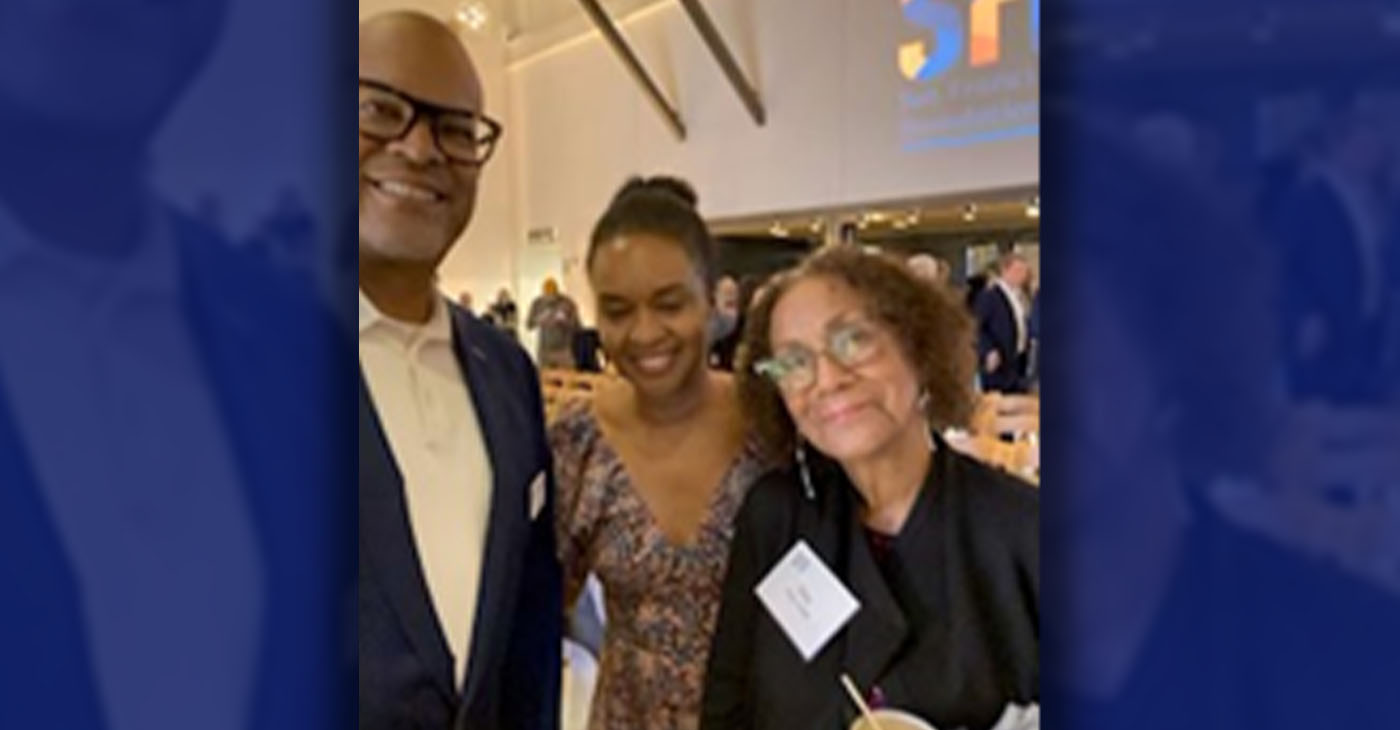
By Conway Jones
The San Francisco Foundation celebrated the 76th anniversary of its founding in 1964 on Thursday, Oct. 24, at The Pearl in San Francisco.
Over 150 people came together with members of the SFF community whose intent was to fulfill the promise of the Bay: democracy, racial equity, affordable housing, and more.
A fireside chat featured SFF CEO Fred Blackwell in conversation with KQED Chief Content Officer and SFF Trustee Holly Kernan.
“I’m not going to sugarcoat it: the past couple of years have been tough. From uncertainty about the future of our nation to ongoing wars and violence globally to Supreme Court decisions that rolled back decades of work on racial equity and reproductive rights – it’s easy to become cynical and fatigued,” said Blackwell.
“Resolve is what is necessary to keep us moving forward in the face of attacks on DEI and affirmative action, of an economy that undervalues arts and caretaking, of a housing shortage that keeps too many of our neighbors sleeping in the streets,” he continued.
Youth Speaks provided poetry and a musical performance by Audiopharmacy, a world-renowned hip-hop ensemble and cultural community arts collective.
The San Francisco Foundation is one of the largest community foundations in the United States. Its mission is to mobilize community leaders, nonprofits, government agencies, and donors to advance racial equity, diversity, and economic opportunity.
Activism
“Two things can be true at once.” An Afro-Latina Voter Weighs in on Identity and Politics
“As a Puerto Rican I do not feel spoken to in discussions about Latino voters… which is ironic because we are one of the few Latino communities who are also simultaneously American,” Ortiz-Cedeño says. Puerto Ricans born in Puerto Rico, a U.S. territory, have American citizenship by birth but they do not have the right to vote for president if they live on the island. “I think that we miss out on a really interesting opportunity to have a nuanced conversation by ignoring this huge Latino population that is indigenously American.”
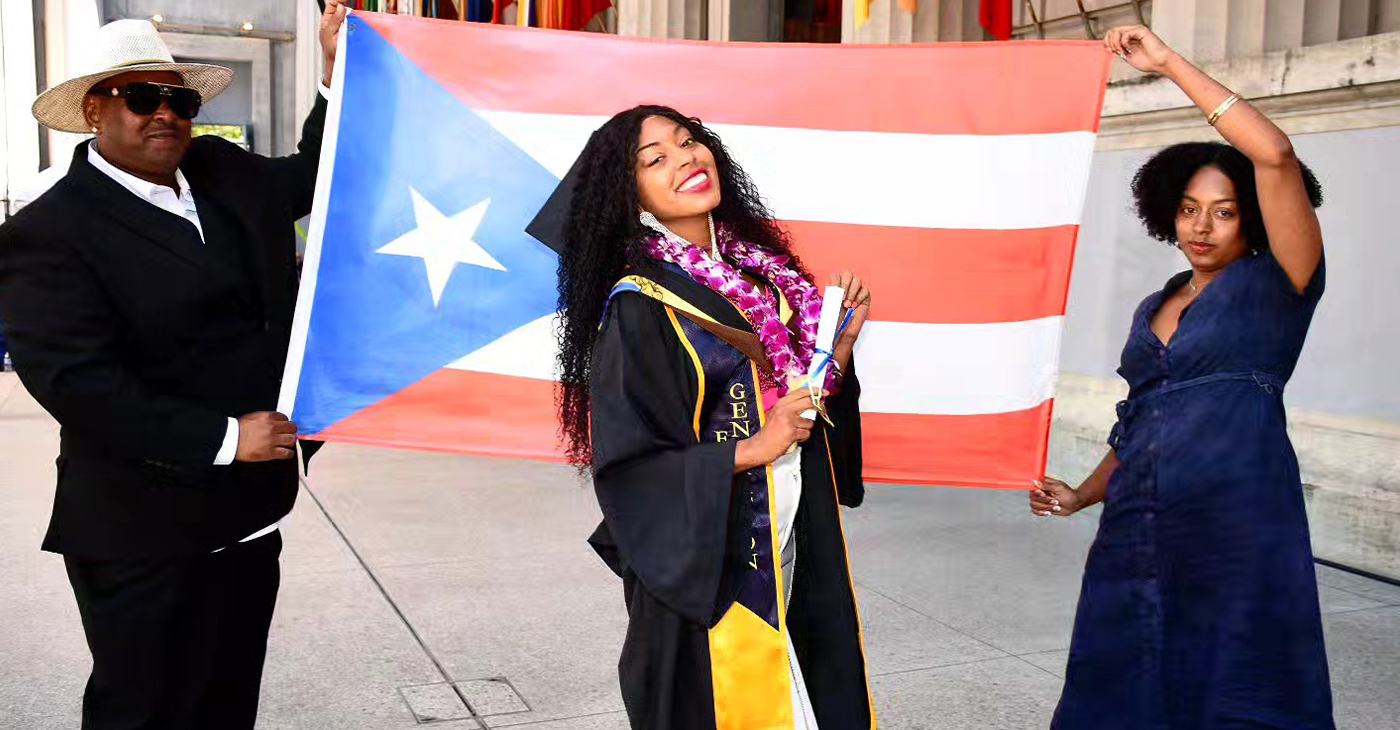
By Magaly Muñoz
On a sunny afternoon at Los Cilantros Restaurant in Berkeley, California, Keyanna Ortiz-Cedeño, a 27-year-old Afro-Latina with tight curly hair and deep brown skin, stares down at her carne asada tacos, “I’ve definitely eaten more tortillas than plantains over the course of my life,” says Cedeño, who spent her childhood in South Texas, among predominantly Mexican-American Latinos. As she eats, she reflects on the views that American politicians have of Latino voters.
“As a Puerto Rican I do not feel spoken to in discussions about Latino voters… which is ironic because we are one of the few Latino communities who are also simultaneously American,” Ortiz-Cedeño says. Puerto Ricans born in Puerto Rico, a U.S. territory, have American citizenship by birth but they do not have the right to vote for president if they live on the island. “I think that we miss out on a really interesting opportunity to have a nuanced conversation by ignoring this huge Latino population that is indigenously American.”
Ortiz-Cedeño, an urban planner who is focused on disaster resilience, homelessness and economic prosperity for people of color, says that political conversations around Latinos tend to shift towards immigration, “I think this ties back into the ways that our perception of ‘Latino’ tends to be Mexican and Central American because so much of our conversation about Latinos is deeply rooted in what’s happening on the border,” she says. “I don’t think that the Afro-Latino vote is frequently considered when we’re talking about the Latino vote in the United States.”
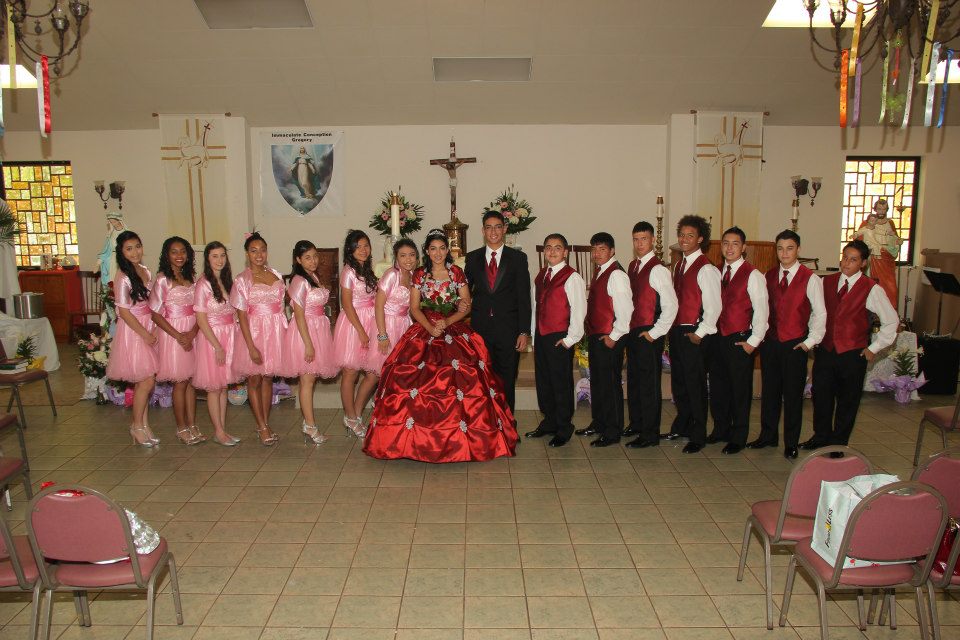
Primarily surrounded by Mexican-Americans while growing up in South Texas, Keyanna participated in many Chicano cultured events, such as being a dama in several quinceñeras. Courtesy photo.
As Ortiz-Cedeño sifts through childhood photos of her as a happy teen dancing with the Mexican ballet folklorico group in high school and as a dama in quinceñeras, she reflects on growing up in South Texas, an area with a large population of white and Mexican-Americans. The Black population was small, and within it, the Afro-Latino population was practically nonexistent.
“It was interesting to try to have conversations with other Latinos in the community because I think that there was a combination of both willful ignorance and a sort of ill intent and effort to try and deny my experience as a Latino,” she says. “There are a lot of folks in Latin America who experience a lot of cognitive dissonance when they think about the existence of Black Latinos in Latin America.
Ortiz-Cedeño comments on the long history of anti-Blackness in Latin America. “Throughout Latin America, we have a really insidious history with erasing Blackness and I think that that has been carried into the Latino American culture and experience,” she says. “People will tell you, race doesn’t exist in Latin America, like we’re all Dominicans, we’re all Puerto Ricans, we’re all Cubans, we’re all Mexicans. If you were to go to the spaces with where people are from and look at who is experiencing the most acute violence, the most acute poverty, the most acute political oppression and marginalization, those people are usually darker. And that’s not by accident, it’s by design.”
Because of the lack of diversity in her Gulf Coast town, as a teenager, despite being the only Spanish-speaker at her job in Walmart, Latinos refused to ask for her help in Spanish.
“Even if monolingual [Spanish-speaking] people would have to speak with me, then they were trying to speak English, even though they could not speak English, versus engaging with me as a Latina,” she says.
“I think that the perception of Latinos in the United States is of a light brown person with long, wavy or straight hair. The perfect amount of curves and the perfect combination of Indigenous and white genes. And very rarely will people also consider that maybe they also have a sprinkle of Blackness in them as well,” she says. “Over 90% of the slave trade went to the Caribbean and Latin America.”
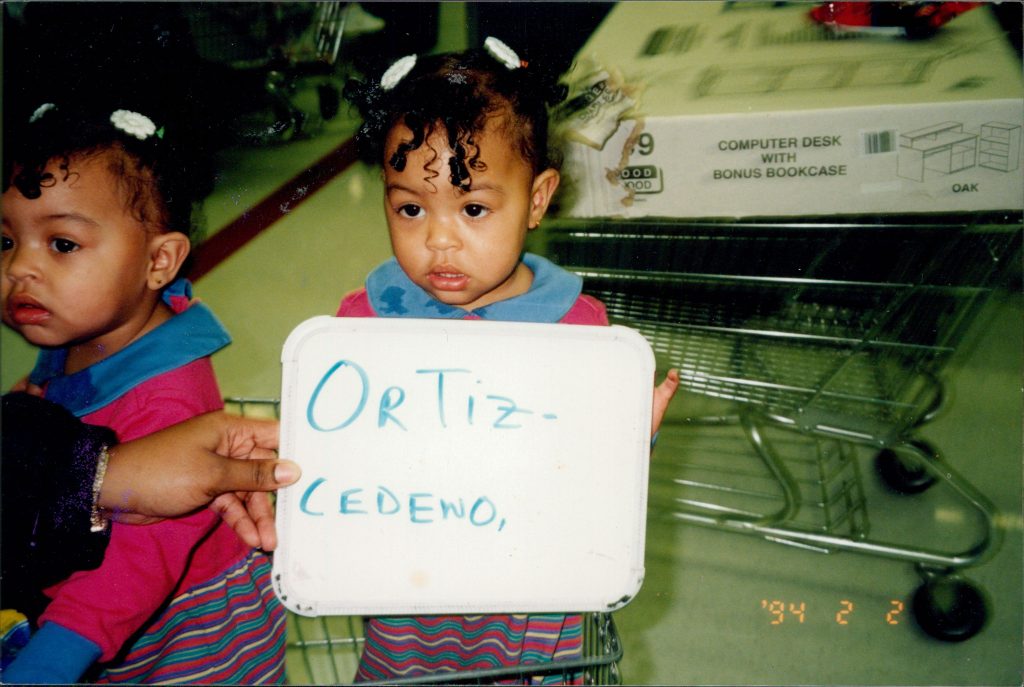
Keyanna as a toddler, holding a whiteboard up with her last name, Ortiz-Cedeño, on it. Courtesy photo.
Ortiz-Cedeño remembers when a Cuban family moved in next door to her in Texas. The teen daughter had blue-eyes, blonde hair and only spoke Spanish, which caused neighboring Latinos to take pause because she didn’t fit the Latino “look” they were used to.
“People didn’t have an option to try and negate her [Latino] identity because they had to acknowledge her for everything that she was,” Ortiz-Cedeño says.
Later on, the girl’s cousins, a Black, Spanish-speaking Cuban family, came into town and again locals were forced to reckon with the fact that not all Latinos fit a certain criteria.
“I think it forced everybody to have to confront a reality that they knew in the back of their mind but didn’t want to acknowledge at the forefront,” Ortiz-Cedeño says.
Having gone through these experiences as an Afro-Latina, Ortiz-Cedeño says it’s easy for her to understand Kamala Harris’ mixed Indian and Jamaican heritage, “It comes really naturally to accept that she is both Indian and Black. Two things can exist at the same time,” she says. “I had a long term partner for about seven years who was South Indian, from the same state as Kamala Harris, so if we had had a kid, they would look like [Harris],” Ortiz-Cedeño jokingly shares.
She says she can relate to having to walk the road of people only wanting to see Harris as a Black American. The talking point about [Harris] not being Indian or not being Black, just deciding to be Black, is really disingenuous and cheap,” she says.
Ortiz-Cedeño believes that the Harris campaign has not capitalized on the vice president’s mixed identity, which could be vital in bringing together different communities to understand each other on a new level and allow for improvements on America’s racial dynamics.

Keyanna co-managed a recovery center with her mother after Hurricane Harvey. They packed essentials, such as diapers, food, and water for families in need. Courtesy photo.
As she rushes into a Berkeley Urban Planning Commission meeting straight out of Ashby BART station, Ortiz-Cedeño explains her love for talking about all things infrastructure, homelessness, and healthcare access. The topics can be dry for many, she admits, but in the end, she gets to address long-standing systemic issues that often hinder opportunities for growth for people of color.
Having lived through the effects of Hurricane Katrina as a child, with the flooding and mass migration of Louisiana residents into Texas, Ortiz-Cedeño was radicalized into issues of displacement, emergency mitigation, and housing at nine years old.
“I remember my principal had to carry her students on her shoulders and swim us home because so many parents were trying to drive in and get their kids from school [due to] the flooding that was pushing their cars away,” she recalls.
Her family relocated to Houston soon after Katrina, only to be met with a deadly Hurricane Rita. They wound up in a mega-shelter, where Ortiz-Cedeño says she heard survivors stories of the unstable conditions in New Orleans and beyond, which got her wondering about urban planning, a term she wasn’t familiar with at the time.
“I think that when you put people in the context of the things that were happening in this country around [these hurricanes], a lot of us started to really think seriously about who gets to make decisions about the urban environment,” she adds.
Watching the heavy displacement of disaster survivors, hearing stories of her Navy veteran father’s chronic homelessness, and her own mother’s work and activism with homeless communities in the non–profit sector put her on the path to progressive politics and solutions, she says. After attending college on the East Coast- where she says she was finally recognized as a Puerto Rican- and working in housing, economic development, and public policy, she returned to California to earn a Master’s in City Regional Planning from UC Berkeley.
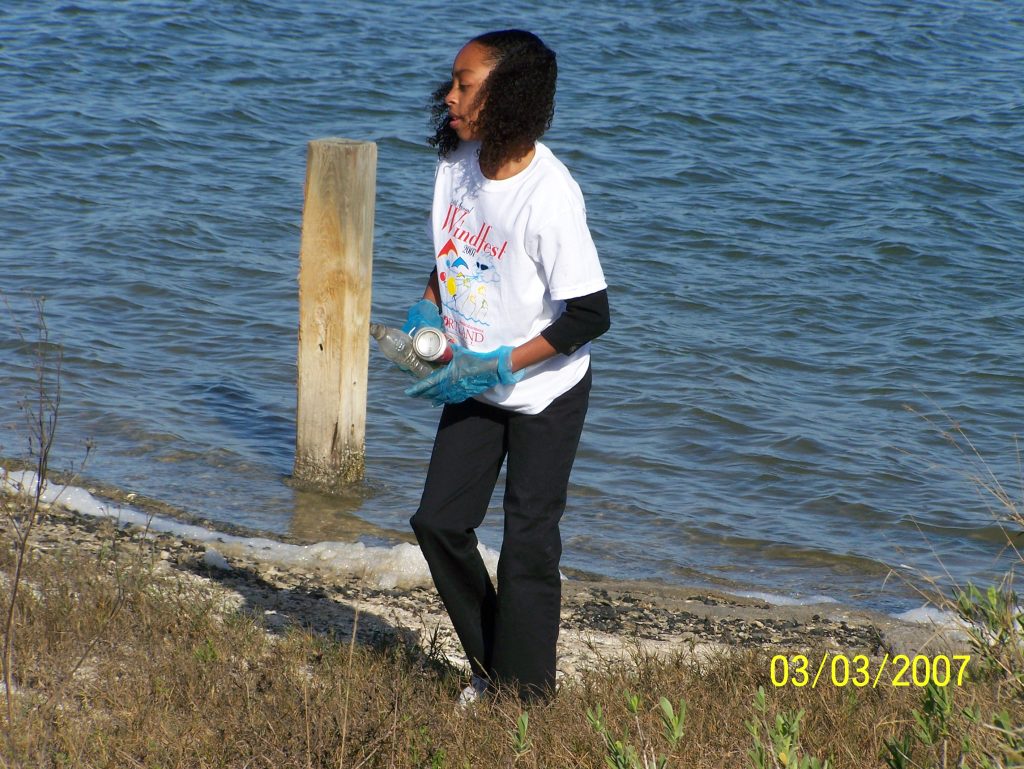
Young Keyanna volunteering at a beach clean up. Activism and giving back to her community has always been a key part of her upbringing. Courtesy photo.
Her vast interest in the urban success of underserved communities even took her abroad to Israel and Palestine when she was an undergraduate college student. “I’ve seen the border with Gaza, I’ve had homestays with farmers in the West Bank,” she says. “For me personally, Palestine is an issue that is really close to the heart.”
“I have a very intimate understanding of the conflict and I’m very disturbed by the way in which the [Democratic] party has not been willing to engage in what I would perceive to be a thoughtful enough conversation about the conflict,” Ortiz-Cedeño says. “The issue of Palestine is going to be one of those that is a make or break issue for her. It has not been one that has been taken seriously enough by the party.”
Ortiz-Cedeño is not under the illusion that one candidate will address every policy issue she wants to see tackled by the president. But she believes it’s better than what former President Donald Trump has to offer.
“Trump has made it very clear what his intentions are with Palestine, and what his relationship is with [Benjamin] Netanyahu,” Ortiz-Cedeño says. “I understand the political strategy that many people are trying to engage in by withholding their vote, but I would also encourage them to re-engage in the political process.”
Casting her vote for Harris is a decision grounded in calculation rather than outright support. “I think I can vote in this election in order to have harm reduction… because I have deep care and concern for other communities that are going to be impacted by a Trump presidency,” Ortiz-Cedeño says.
She also hopes that American politicians will consider the nuance and perspective that Afro-Latinos bring to the table when it comes to politics, policy, and race in America, “When we don’t think expansively about who is Latino in the United States, the breadth of Latino experiences in the United States, we miss an opportunity to capture how diverse Latinos interests are politically.”

This story was reported in collaboration with PBS VOCES: Latino Vote 2024.
-

 Alameda County4 weeks ago
Alameda County4 weeks agoAlameda County District Attorney Pamela Price Announces $7.5 Million Settlement Agreement with Walmart
-

 Activism3 weeks ago
Activism3 weeks ago‘Jim Crow Was and Remains Real in Alameda County (and) It Is What We Are Challenging and Trying to Fix Every Day,’ Says D.A. Pamela Price
-

 Bay Area4 weeks ago
Bay Area4 weeks agoIn the City Attorney Race, Ryan Richardson Is Better for Oakland
-

 Activism3 weeks ago
Activism3 weeks agoOakland Post: Week of October 30 – November 5, 2024
-

 Alameda County3 weeks ago
Alameda County3 weeks agoD.A. Price Charges Coliseum Flea Market Vendors in Organized Retail Theft Case
-

 Activism3 weeks ago
Activism3 weeks ago‘Criminal Justice Reform Is the Signature Civil Rights Issue of Our Time,’ says D.A. Pamela Price
-

 Activism2 weeks ago
Activism2 weeks agoLIVE! — TOWN HALL ON RACISM AND ITS IMPACT — THURS. 11.14.24 5PM PST
-

 Activism4 weeks ago
Activism4 weeks ago“Two things can be true at once.” An Afro-Latina Voter Weighs in on Identity and Politics






















































